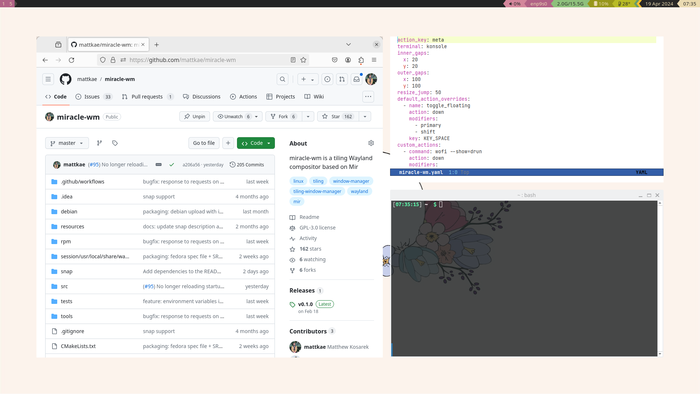Matthew Kosarek of Canonical presented second release of composite manager miracle-wmusing the Wayland protocol and components for building composite managers Mir. Miracle-wm supports window manager-style tiling i3 and the user environment Sway. Can be used as a panel waybar. The project code is written in C++ and distributed by licensed under GPLv3. Finished assemblies are formed in the format snap.
The goal of the project is to create a composite server that uses tiled window management, but is more functional and stylish than projects such as Swayfx. Miracle-wm is expected to be useful for users who prefer a tiled layout but would like to explore visual effects and brighter graphics with smooth transitions and colors. To install miracle-wm you can use the command “sudo snap install miracle-wm –classic”.
Advertisement
While the first release was seen as an initial prototype, version 0.2 is focused on stabilization and improving usability. Among the changes in version 0.2:
- Added a floating window manager that allows you to place individual windows on top of a tiled grid, similar to traditional window managers.
- It is possible to attach windows to a specific place on the desktop.
- It is possible to automatically apply new settings without restarting when the configuration file is changed.
- Added IPC support for i3 window manager for desktops. The implemented features are enough to launch the Waybar panel.
- A terminal parameter has been added to the configuration file to define the default terminal emulator that is launched when using the Ctrl+Alt+T keyboard shortcut.
- In the configuration file, it is now possible to specify environment variables, for example, mesa_glthread=false, to combat tearing in the output.
- The version of Mir we are using has been updated to release 2.16.4, which adds support for a hardware cursor and takes into account the ability to rotate the screen when taking screenshots.
- Performance optimization has been carried out.
- The formation of packages for Ubuntu and Fedora Linux has been established.
June 1st planned publish release 0.3, which will have prerelease status. Version 0.3 will include support for animation effects, stacked window layouts, multi-monitor configurations, screen customization options, and visual highlighting of active windows. The first stable release of the project – 1.0 – is scheduled for July 15th.
Ideas that could be included in version 1.0 include an overview mode for navigating windows and desktops in a GNOME style; graphical interface for configuration; context menus with actions on windows; picture-in-picture mode; the ability to display the application window that has the focus in the center; minimal shell with a panel and program launch interface.
Advertisement
Thanks for reading:
